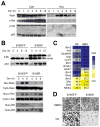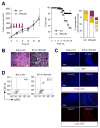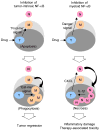Cell-selective inhibition of NF-κB signaling improves therapeutic index in a melanoma chemotherapy model
- PMID: 22389871
- PMCID: PMC3290412
- DOI: 10.1158/2159-8290.CD-11-0143
Cell-selective inhibition of NF-κB signaling improves therapeutic index in a melanoma chemotherapy model
Abstract
The transcription factor NF-κB promotes survival of cancer cells exposed to doxorubicin and other chemotherapeutic agents. IκB kinase is essential for chemotherapy-induced NF-κB activation and considered a prime target for anticancer treatment. An IκB kinase inhibitor sensitized human melanoma xenografts in mice to killing by doxorubicin, yet also exacerbated treatment toxicity in the host animals. Using mouse models that simulate cell-selective targeting, we found that impaired NF-κB activation in melanoma and host myeloid cells accounts for the therapeutic and the adverse effects, respectively. Ablation of tumor-intrinsic NF-κB activity resulted in apoptosis-driven tumor regression following doxorubicin treatment. By contrast, chemotherapy in mice with myeloid-specific loss of NF-κB activation led to a massive intratumoral recruitment of interleukin-1β-producing neutrophils and necrotic tumor lesions, a condition associated with increased host mortality but not accompanied by tumor regression. Therefore, a molecular target-based therapy may be steered toward different clinical outcomes depending on the drug's cell-specific effects.
Significance: Our findings show that the IκB kinase–NF-κB signaling pathway is important for both promoting treatment resistance and preventing host toxicity in cancer chemotherapy; however, the two functions are exerted by distinct cell type–specific mechanisms and can therefore be selectively targeted to achieve an improved therapeutic outcome.
Keywords: NF-κB; efficacy; melanoma; neutrophil; toxicity.
© 2011 AACR.
Figures







Comment in
-
NF-κB in cancer: a matter of life and death.Cancer Discov. 2011 Nov;1(6):469-71. doi: 10.1158/2159-8290.CD-11-0260. Cancer Discov. 2011. PMID: 22586649 Free PMC article.
Similar articles
-
BMS-345541 targets inhibitor of kappaB kinase and induces apoptosis in melanoma: involvement of nuclear factor kappaB and mitochondria pathways.Clin Cancer Res. 2006 Feb 1;12(3 Pt 1):950-60. doi: 10.1158/1078-0432.CCR-05-1220. Clin Cancer Res. 2006. PMID: 16467110 Free PMC article.
-
KINK-1, a novel small-molecule inhibitor of IKKbeta, and the susceptibility of melanoma cells to antitumoral treatment.J Natl Cancer Inst. 2008 Jun 18;100(12):862-75. doi: 10.1093/jnci/djn174. Epub 2008 Jun 10. J Natl Cancer Inst. 2008. PMID: 18544741
-
NF-kappaB inhibition through proteasome inhibition or IKKbeta blockade increases the susceptibility of melanoma cells to cytostatic treatment through distinct pathways.J Invest Dermatol. 2010 Apr;130(4):1073-86. doi: 10.1038/jid.2009.365. Epub 2009 Nov 26. J Invest Dermatol. 2010. PMID: 19940859
-
The NF-kappaB activation pathways, emerging molecular targets for cancer prevention and therapy.Expert Opin Ther Targets. 2010 Jan;14(1):45-55. doi: 10.1517/14728220903431069. Expert Opin Ther Targets. 2010. PMID: 20001209 Free PMC article. Review.
-
NF-κB in the crosshairs: Rethinking an old riddle.Int J Biochem Cell Biol. 2018 Feb;95:108-112. doi: 10.1016/j.biocel.2017.12.020. Epub 2017 Dec 23. Int J Biochem Cell Biol. 2018. PMID: 29277662 Free PMC article. Review.
Cited by
-
Phase I trial of bortezomib and dacarbazine in melanoma and soft tissue sarcoma.Invest New Drugs. 2013 Aug;31(4):937-42. doi: 10.1007/s10637-012-9913-8. Epub 2013 Jan 13. Invest New Drugs. 2013. PMID: 23315028 Free PMC article. Clinical Trial.
-
Combination of ERK2 inhibitor VX-11e and voreloxin synergistically enhances anti-proliferative and pro-apoptotic effects in leukemia cells.Apoptosis. 2019 Dec;24(11-12):849-861. doi: 10.1007/s10495-019-01564-6. Apoptosis. 2019. PMID: 31482470 Free PMC article.
-
The Direct and Indirect Roles of NF-κB in Cancer: Lessons from Oncogenic Fusion Proteins and Knock-in Mice.Biomedicines. 2018 Mar 19;6(1):36. doi: 10.3390/biomedicines6010036. Biomedicines. 2018. PMID: 29562713 Free PMC article. Review.
-
Epithelial Control of Gut-Associated Lymphoid Tissue Formation through p38α-Dependent Restraint of NF-κB Signaling.J Immunol. 2016 Mar 1;196(5):2368-76. doi: 10.4049/jimmunol.1501724. Epub 2016 Jan 20. J Immunol. 2016. PMID: 26792803 Free PMC article.
-
Intracellular signaling modules linking DNA damage to secretome changes in senescent melanoma cells.Melanoma Res. 2020 Aug;30(4):336-347. doi: 10.1097/CMR.0000000000000671. Melanoma Res. 2020. PMID: 32628430 Free PMC article.
References
-
- Savage P, Stebbing J, Bower M, Crook T. Why does cytotoxic chemotherapy cure only some cancers? Nat Clin Pract Oncol. 2009;6:43–52. - PubMed
-
- Cotter TG. Apoptosis and cancer: the genesis of a research field. Nat Rev Cancer. 2009;9:501–7. - PubMed
-
- Paulus P, Stanley ER, Schäfer R, Abraham D, Aharinejad S. Colony-stimulating factor-1 antibody reverses chemoresistance in human MCF-7 breast cancer xenografts. Cancer Res. 2006;66:4349–56. - PubMed
-
- Ghiringhelli F, Apetoh L, Tesniere A, Aymeric L, Ma Y, Ortiz C, et al. Activation of the NLRP3 inflammasome in dendritic cells induces IL-1β-dependent adaptive immunity against tumors. Nat Med. 2009;15:1170–8. - PubMed
Publication types
MeSH terms
Substances
Grants and funding
LinkOut - more resources
Full Text Sources
Medical

